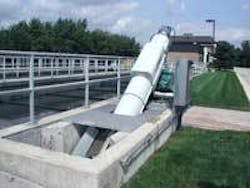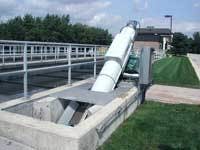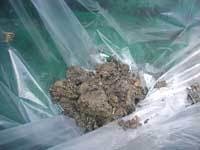Rotating Drum Screen Handles Grease, Skimmings
Primary settling tank grease and skimmings are difficult materials to process at wastewater treatment facilities. While many facilities tend to pump this scum into their digesters, it is difficult to mix and more difficult to biologically stabilize, forcing plants to look for other methods of treatment.
The Wheaton Sanitary District, Wheaton, Illinois, operates with three rectangular chain and flight primary clarifiers. Surface scum and other floatables were skimmed into a pit to be decanted then pumped to an externally fed drum screen. The screen was located in one building and the pump in another with the process running five steps: skimming/decanting, pumping, filtering, and conveyance to a dumpster.
While testing septage screening equipment for a new receiving station, the staff at Wheaton noted the capability of a different type of rotating drum screen, which handles grease and solid material by removing, dewatering and compacting in one machine. The unit, Lakeside Equipment Corporation’s Raptor® Rotating Drum Screen (RDS), was brought in to test its handling of grease and floating material removed by the skimming troughs.
The RDS, with 0.5mm-spaced wedge wire, receives skimmings from the scum pit next to the screen, effectively removing grease and solid material. The material enters the rotating drum where it is screened and deposited in the screw conveyor to be dewatered and compacted. Discharged screenings were a solid material of grease and debris.
It became apparent during testing the RDS could perform the five-step process of scum handling with one piece of equipment. After further testing, the plant concluded the RDS could be installed directly into the scum pit, eliminating the need for pumping. The District contacted Lakeside and purchased a 31-inch Rotating Drum Screen for installation directly into the existing scum pit.
Skimmings from three sedimentation tank troughs enter the chamber through a common pipe. Operator attention is minimal as the unit operates automatically based on preset water levels. The first processed material was visibly free of liquids and accepted by the landfill and wastehauler.
The staff inspected the filtrate that had passed through the drum screen as it left the scum pit and flowed down the lowered decant tube. The filtrate was clear and contained little solids. It looked like the drum screen was going to work.
The Rotating Drum Screen has now provided 5 years of reliable scum processing in one unit. The discharged material passes paint filter testing for free liquids and provides a quick, economical and clean way to process primary tank skimmings. WW
About the Authors:
Steve Bollweg is the Plant Superintendent at Wheaton Sanitary District, Wheaton, Illinois. In the 2005, the District was awarded by the EPA for 2nd Place Operations and Maintenance Excellence Award for Medium Advanced Plant. He can be reached at 630-668-1511 or at [email protected].
Jim McKee has worked at Lakeside Equipment Corporation for more than seven years as a Sales Engineer. His previous experience includes 15 years at wastewater treatment plants in Ohio and Illinois. He can be reached at 630-837-5640 or at [email protected].


